How to Grow Tomatoes for Beginners
If you are a gardener, then you are probably a grower of tomatoes. Quite possibly the most popular vegetable to grow because it is so versatile. This article will walk you through How to Grow Tomato for Beginners; even if you have been growing tomatoes for years, it is a great refresher guide to read over.
Add this staple to your gardening 101 library so you can grow the best year after year.
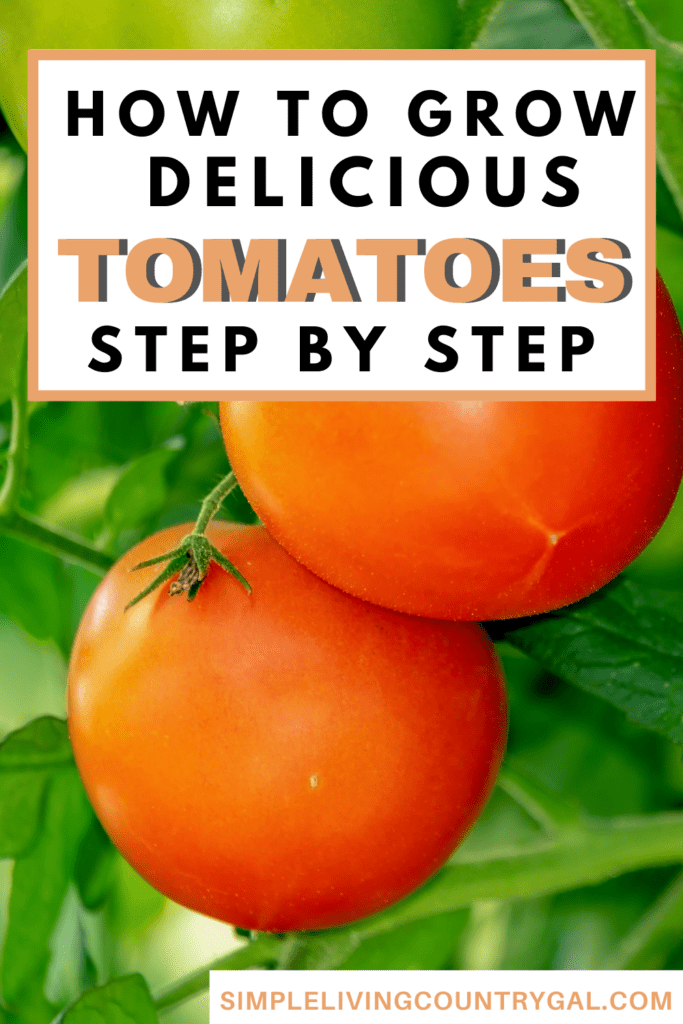
Tomatoes are a great option for any vegetable garden. Plants are relatively inexpensive to buy, they produce pounds of tomatoes to enjoy, they are easy to preserve so you can enjoy them all winter long, and they fit in every garden size from a small balcony garden to a large garden spot in your yard.
Growing tomatoes for beginners can be a little tricky, though, as tomatoes can be a little difficult to get right. Choosing the right variety will help to get you off to a good start. Along with that, you will need to have plenty of sunlight, frequent, steady watering, adequate support, and healthy soil.
Yes, tomatoes can require some attention, but the work will be worth it in the end when you’re enjoying your delicious harvest.
How to Grow Tomatoes for Beginners
Tomatoes (Solanum Lycopersicum) are a warm-weather crop that requires a long growing time. If you live in a warmer climate, you’ll need to plant seeds in early spring. If you live in a colder climate, you can get a jump on planting by using seedlings that have already begun to grow.
Be sure to grab our FREE how to grow tomatoes guide at the end of this post!
There are two main types of tomatoes to consider, determinate (bush plants) and indeterminate (vine plants). Determinate varieties grow about 2 to 3 feet tall and produce a lot of tomatoes at one time. They grow for a shorter period of time than indeterminate varieties, but they’re a great option for small garden spaces and container gardening.
Indeterminate varieties produce larger tomatoes, perfect for slicing, that are ready to harvest mid to late season. They’ll continue to produce until the first frost. These varieties have more leaf growth than determinate varieties, so the tomato harvest is spread out more evenly throughout the season. These varieties will need staking for their vines so they’re better off in larger garden areas.
There are several varieties available, some of the most common to choose from include:
There are so many wonderful varieties of tomatoes that you can try to grow in your backyard garden. Below is a brief overview of the most popular. If you want more details on the varieties of tomatoes you can read more here.
- Early Cascade – an early variety that is ready to harvest in about 70 days. It’s an indeterminate variety that produces clusters of tomatoes and is disease-resistant.
- Early Girl – another early, indeterminate variety that produces large tomatoes throughout the season.
- Floramerica – a determinate disease-resistant variety that is ready to harvest in 70-80 days.
- Fantastic – an indeterminate variety that is resistant to both disease and cracking. It’s ready to harvest in 70-80 days and produces a high yield.
- Tomato, Roma VF – determinate, compact tomato that is resistant to wilting. It’s a meaty tomato with few seeds and provides a good yield. This is a good variety for canning and making tomato paste.
- Cherry Tomato Varieties – a few options include Sun Gold, Matt’s Wild Cherry, and Yellow Mini. All are indeterminate varieties that are ready to harvest in 55-60 days. Most are resistant to disease and many are resistant to splitting.
- Large Varieties – these include Beefsteak, Beefmaster, Ponderosa, and Oxheart. While these varieties produce larger tomatoes, they are also more susceptible to disease and cracking.
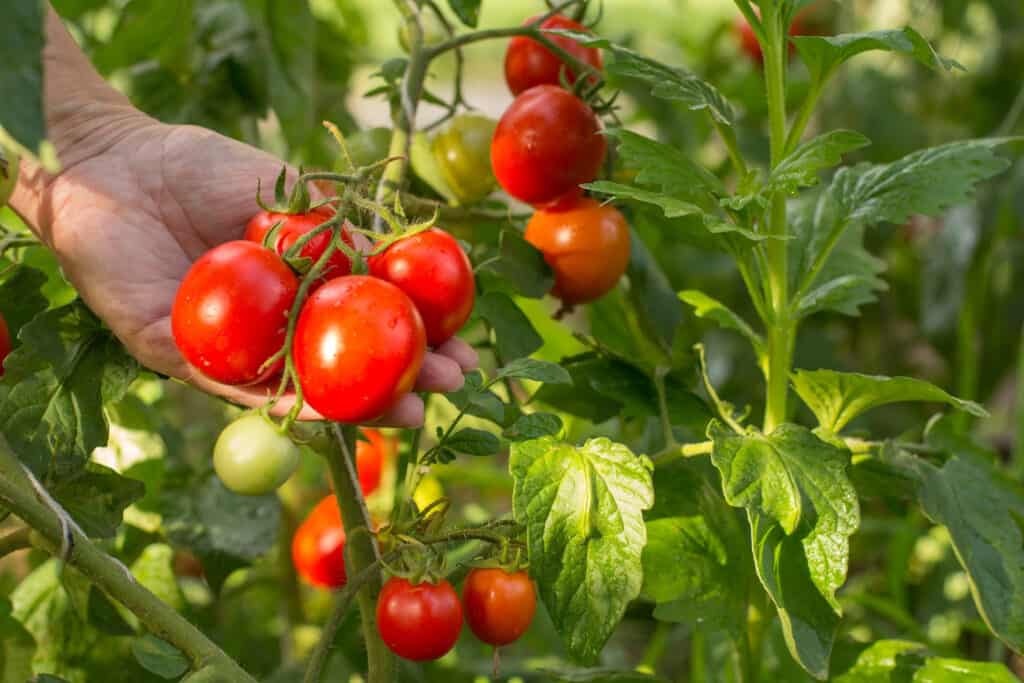
Seed, Bulb, or Plant?
Tomatoes are planted as seeds, but many gardeners choose to purchase starter tomato plants from nurseries to speed up harvesting time. You can also start your plants from seed indoors. This is a great way to ensure you know the quality of your tomato plants from the very start. Read, how to start tomatoes indoors from seed.
What You Need to Grow Tomatoes
When it comes to growing tomatoes, one of the most important things you’ll need is a spot that gets plenty of direct sunlight, 6 to 8 hours a day. You’ll also need a spot where you haven’t grown tomatoes or any of their relatives (especially potatoes, eggplant, and peppers) in the last couple of years. Rotating the crop will help to eliminate soil-borne diseases.
If planting in the ground, you’ll need to dig the soil about a foot deep, mix in aged manure and/or compost, then give the soil about 2 weeks to break down before planting.
When to Plant Tomatoes
Tomatoes are a warm-weather crop that thrives on higher temperatures. If sowing seeds outdoors, you’ll need to wait until the soil warms up to at least 60° F before planting but 70° F is optimum for a fast germination, within 5 days.
You can start your seeds indoors though for a shorter growing season. Plan on starting your seeds 6 to 8 weeks before the last frost of spring. Sow the seeds about a ½ inch deep in small trays. The seedlings can then be easily replanted outdoors once the soil warms up. Be sure to harden the seedlings off for about a week before transplanting them. Set them outdoors in a shady spot for a few hours on the first day then gradually increase the amount of time each day and start to introduce them to some direct sunlight.
Temperature
Temperatures will need to be consistently warm to help the tomato plants thrive. Soil temperatures should be at least 60° F before planting and outdoor temperatures should be at least 65° F, but the warmer the temperatures, the more the plants will thrive.
Sun
Once planted, tomatoes will need to enjoy at least 6 to 8 hours of direct sunlight a day to thrive.
Soil
Tomato plants can soak up nutrients better when the soil pH is between 6.2 and 6.8. They’ll need both major and minor nutrients which can be provided by mixing compost and/or manure into the soil and letting it rest for 2 weeks before planting then adding a continuous-release fertilizer with calcium to the planting holes when planting.
Water
Tomato plants will need at least 1 inch of water a week but it’s important to water frequently, a little at a time, instead of just once a week. Watering regularly and deeply will help the plants develop fruits. Irregular watering can lead to blossom end rot, a calcium deficiency) as well as cracking and splitting.
During hot spells, your plants may need more water. If they look wilted, it’s time to water.
Fertilizing
Fertilize the soil with manure or compost 2 weeks before planting then add a phosphorus-rich fertilizer to the plant holes when planting. Do not use a nitrogen-rich fertilizer as this will increase the foliage and delay the flowering and fruiting of the plant.
Side dress plants about every 2-3 weeks once the tomatoes are about 1 inch in diameter and continue to fertilize until the first frost.
Support
Tomato plants require a support system to help them grow and keep the fruits off the ground. This will allow them to grow upwards, creating more space for the plants, and keeping them off the ground will help to reduce pests and disease.
Use tomato cages, tomato stakes, or a trellis system to encourage the plants in an upward growth.
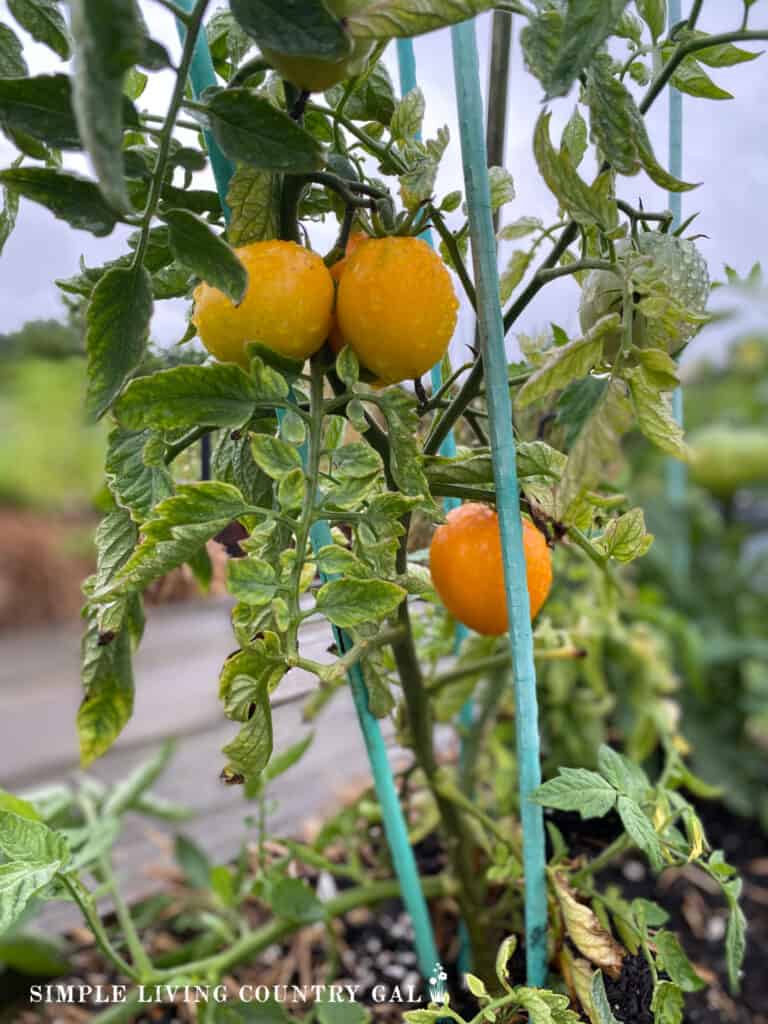
How Much to Plant
Since tomato plants produce a large harvest and continue to fruit over the season, you will only need to plant 1-2 cherry tomato plants per person or 2-4 slicing tomato plants per person in your household. If you would like extra tomatoes for canning, add a few more plants to the garden.
How Long Do Tomatoes Take to Grow?
Most varieties will be ready to harvest in 55-70 days, although some varieties can take up to 100 days to mature.
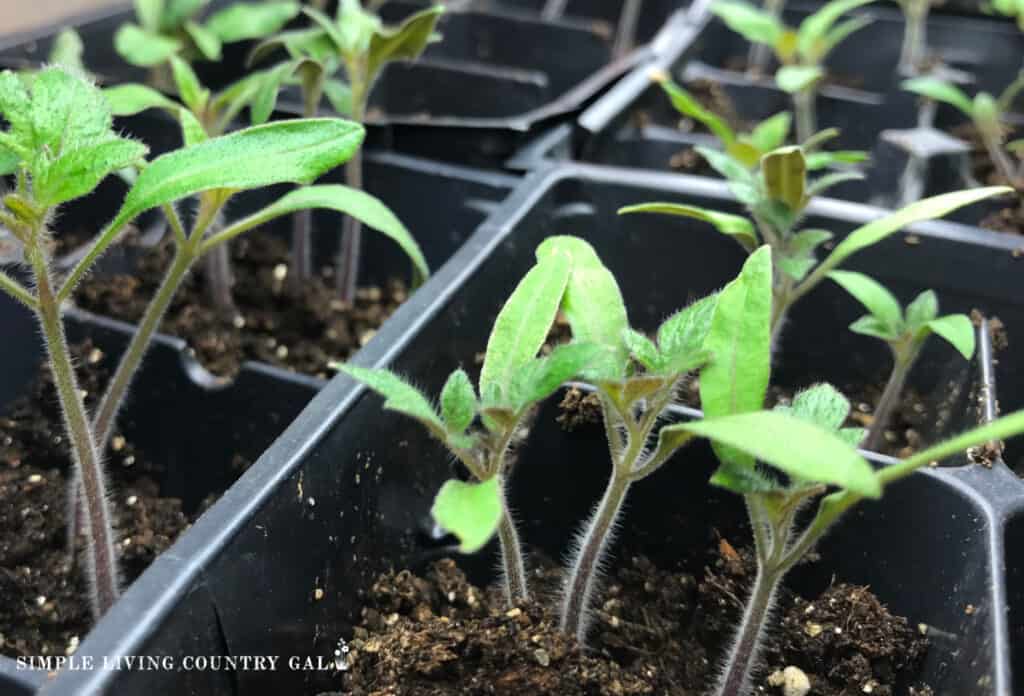
How to Plant Tomatoes
Before planting, be sure to select an area that receives plenty of direct sunlight during the day. Dig the soil about 12 inches deep and add compost or manure to the soil 2 weeks before planting. Re-cover the area and allow the soil to absorb the nutrients.
Be sure the soil is at least 60° F before planting, but 70° F is optimal. If the soil isn’t warming fast enough, cover it with black plastic for a week or two before planting to help it warm up.
Decide on your support system and have it ready before planting. Caging, stakes, and trellises all work well. They’ll take up space in the garden though so you’ll need to plan that into the space you’re using.
If planting seeds, place a few of them in a group about a ¼ inch deep and space the groups out by at least 12 inches. You’ll need to thin the plants out as they start to grow.
If planting seedlings, make sure they’re covered at least to the lowest leaves. Some gardeners like to plant so that the bottom leaves are buried. This can help the plants grow stronger. Seedlings will require you to trench the ground before planting, at least 3-4 inches deep, allowing the roots plenty of room to spread out.
Water well after planting and continue to water regularly throughout the growing season. If the plants look wilted, water that day.
Spacing
Space seedlings about 2 feet apart when planting to give them plenty of room to spread out and to allow room for caging or other support. When planting seeds, plant a few seeds about every foot then thin out as they start to sprout.
Depth
If planting seeds, plant them a ¼ inch deep. When planting seedlings, trench the ground 3-4 inches deep and plant up to the lowest leaf. You can even plant them deeper with the lowest leaves slightly below ground level; the roots will sprout on the stems and this can lead to more fruit.
Growing Tips for Tomatoes
- Don’t use a high nitrogen fertilizer; this will promote foliage and delay flowering and fruiting.
- When transplanting, you can add a handful of organic tomato fertilizer or bone meal to the planting hole for more phosphorus.
- Place staking or caging at the time of planting to keep the fruit off the ground and help avoid pests and disease.
- When transplanting seedlings, water well at the time of planting to reduce shock to the roots.
- Cover your tomato beds with a layer of straw, mulch, or grass clippings to prevent weeds.
- It’s best to water tomato plants in the early morning so that they have plenty of moisture throughout the hot summer days.
- Avoid overhead watering and watering in the afternoon, this will help the soil absorb more moisture and reduce disease.
- Mulching a few weeks after transplanting will help the soil retain moisture and keep the soil from splashing water on the leaves.
- Placing flat rocks on the soil next to each plant will help to prevent the water from evaporating out of the soil.
- If flowers aren’t forming or flowers form but don’t fruit, it usually means they’re not getting enough sun or water.
How to Harvest Tomatoes
Leave tomatoes on the vine as long as possible and harvest when they are firm and very red. Gently tug them off the vine without disturbing the plant when they’re ready to be harvested. As they get close to maturity, check the plants daily.
How to Store Tomatoes
Tomatoes are best left on the kitchen counter at room temperature, never refrigerate them as this can spoil the flavor and texture.
If freezing, core fresh, unblemished tomatoes and place them in a freezer bag, still whole. Seal and label the bag and freeze. The skins will slip off as they thaw.
Diseases and Pests to Watch Out For
Tomatoes are susceptible to a variety of insects and pests. Check the under leaves daily as well as the fruit and near the soil. Aphids and Tomato Hornworms are most common. Spray plants with a jet stream from the hose or handpick them off with gloved hands and drop them in a bucket of soapy water.
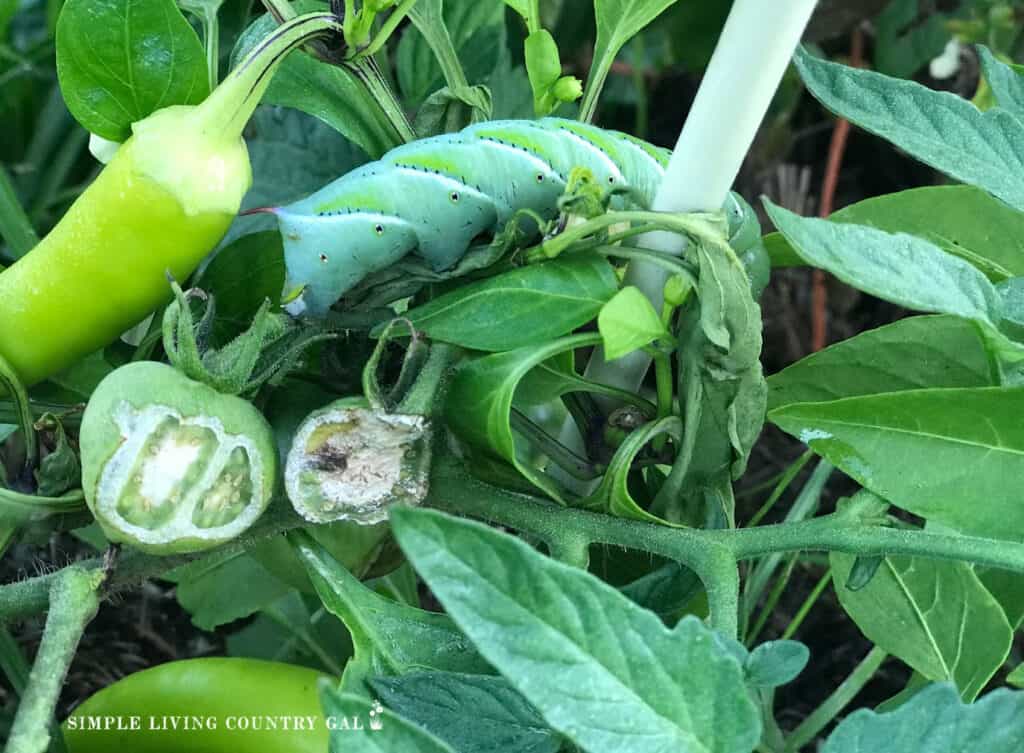
Many varieties are resistant to disease, but it’s best to rotate crops every 3 years to help prevent soil-borne diseases. Make sure the soil is well-draining and that you’ve mixed compost or manure into it before planting. Water regularly but don’t overwater if you’ve forgotten one day.
Tomato plants can be a little bit challenging to grow for a beginner garden, but by following a few simple tips on how to grow tomatoes for beginners and watching them closely, they’ll grow wonderfully in your garden and provide a nice harvest to enjoy all summer.
